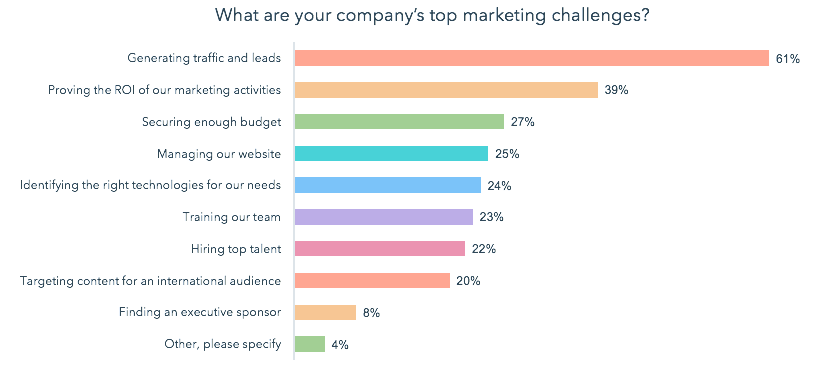![[Best of 2019] These 3 common marketing mistakes are poking holes in your funnel](https://img-cdn.tnwcdn.com/image?fit=1280%2C720&url=https%3A%2F%2Fcdn0.tnwcdn.com%2Fwp-content%2Fblogs.dir%2F1%2Ffiles%2F2019%2F04%2F59.png&signature=568b2701981fc5525947670d5446bcfb)
Are you converting as many people as your product is capable of converting?
It’s a question I think about a lot when I’m working on my marketing projects. Is there a gap between the quality of the product and the quality of my marketing? Is my marketing funnel underselling a phenomenal product?
It might seem like a silly question, but it’s something many marketers struggle with. Some 61 percent of marketers list “generating traffic and leads” among the top challenges they face, and 39 percent select “proving the ROI of our marketing activities.” And those are challenges that cripple the very core of a marketer’s purpose (to generate leads and improve ROI).

But from my perspective, it seems like most marketers are making the same mistakes – common funnel-draining mistakes that are fixable over just a few weeks or maybe months.
From my experience, these are three of the most common snafus.
1. You’re ignoring the facts (AKA data)
Perhaps no industry changes as quickly as the marketing industry. The psychology of why people buy doesn’t change, of course, but the methods do. Not long ago, for instance, only deluded marketers would have hedged their bets on the lead-generating prowess of LinkedIn. Now, it’s a platform representing 500 million members with tips emerging from every corner of the web with a quick “generate leads on LinkedIn” Google search.
Facebook advertising, SEO best practices, and even the up-and-coming Tik-Tok have changed and are consistently changing the marketing environment.
If you stop paying attention, you fall behind.
But that doesn’t just apply to the marketing space as a whole, it applies to your market specifically – the people who stand to benefit most from your products.
Every company is different, and so too is every market. And if you don’t pay close attention to how your prospects are interacting with your marketing touchpoints, you’ll convert less people than you could – it’s that simple.
Sadly, 74 percent of marketers admit that they don’t know how to track their data. Don’t be one of them. Install and fully understand Google Analytics, use a heatmap and A/B testing tool like VWO or CrazyEgg, and use UTMs to track links clicks. Your lead generation volume will thank you.
2. People are entering your funnel for the wrong reason
The bottom of your marketing funnel is going to leak like the Titanic after a long voyage if you don’t put the right people in that funnel.
From my experience, the reason that people sign up for your email list should be very similar to the reason that they buy your products, or at least related. If they sign up for your email list because they want to win a free trip to the Caribbean and then you try to sell them enterprise-grade IT automation software, it might not be the best fit.
Similarly, I’ve found that using PR to get mentions on sites relevant to your target market (i.e. where your prospects spend time) and working with influencers who already have a following full of your ideal customers are two great ways to ensure you’re attracting the right people to your funnel.
This point is well illustrated with the power of the Facebook pixel, as explained in this case study. Paleo Bakehouse was a modest home business based in Miami.
Looking to boost sales, the couple behind the business sought the help of Juice, a digital advertising agency, which changed up the way that Paleo Bakehouse was running their Facebook ads. Simply by switching campaigns to the conversion ad objective, adding a Facebook pixel to the client’s website, leveraging lookalike audiences, and retargeting stickier website visitors, they were able to make sure their paid media reached people who had already demonstrated interest in Paleo Bakehouse’s products. This change alone resulted in a 260 percent increase in purchases and over $311,000 in revenue lift.
Of course, that’s just one example of what can happen when you focus your time and energy on converting people who have signalled interest in your products. But this simple truth applies to all of your marketing efforts and your funnel as a whole. Attract the right people to your funnel in the first place, and they’ll be far more likely to buy your products when the time comes.
3. You don’t understand your ideal market (but you think you do)
It’s easy to assume that you understand your target market – that with some quick visualizations and inference-making, you’ll create a useful customer avatar.
And to some degree that’s true. There’s certainly something to be said for putting yourself in your target market’s shoes.
The problem is, 80 percent of consumers don’t feel understood by the average brand. Which means that you have to be the one that really gets them. But you know the most surefire way to understand your market?
Ask them what they want, what they fear, who they are, what they do, how many kids they have, why they’re on your list, and lots of other revealing questions. The more you really know about your market (rather than just think you know), the better you’ll be able to cater your marketing materials specifically to those people and their needs.
Surveys work wonderfully. So too does calling your customers, spending time in the forums where your target market hangs out – even looking at competitors who are trying to communicate with a similar market can help you understand the people you’re trying to convert.
ConversionXL is proof of this. After launching CXL Institute, the company watched as purchases and engagements plummeted month after month for a full quarter. As a final hail mary (before calling it quits), CXL used surveys to try and figure out why people weren’t engaging with the new product like they had expected. Eventually, they found out that people weren’t buying for two primary (and easy-to-fix) reasons: the price was too expensive and they didn’t have time to actually use it.
With that, they changed their targeting for the product to focus on bigger businesses with more generous budgets, and now, according to a case study from Hotjar, the CXL Institute’s business is healthy and sustainable. But they never would have known how to fix it if they didn’t take the time to understand their market.
Fixing your leaky funnel
The reality is, most funnels leak for only a few reasons – the same reasons. And it’s rarely because of a bad product (even a terrible product can sell like hotcakes with the right marketing) or lack of product-market fit. More often, it’s because you’re ignoring the data, people are entering your funnel for the wrong reasons, or you don’t fully understand your ideal market.
Fortunately, plugging those holes is relatively simple. Pay more attention to the data (and set up tracking if you don’t already have it), create interest consistency across the entire customer experience, and send surveys to your past customers.
With that, you’ll be head-and-shoulders above most other marketers.
Get the TNW newsletter
Get the most important tech news in your inbox each week.





